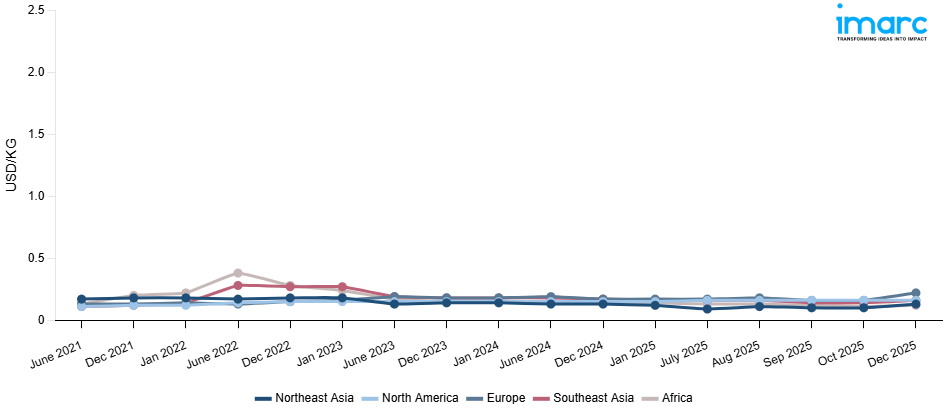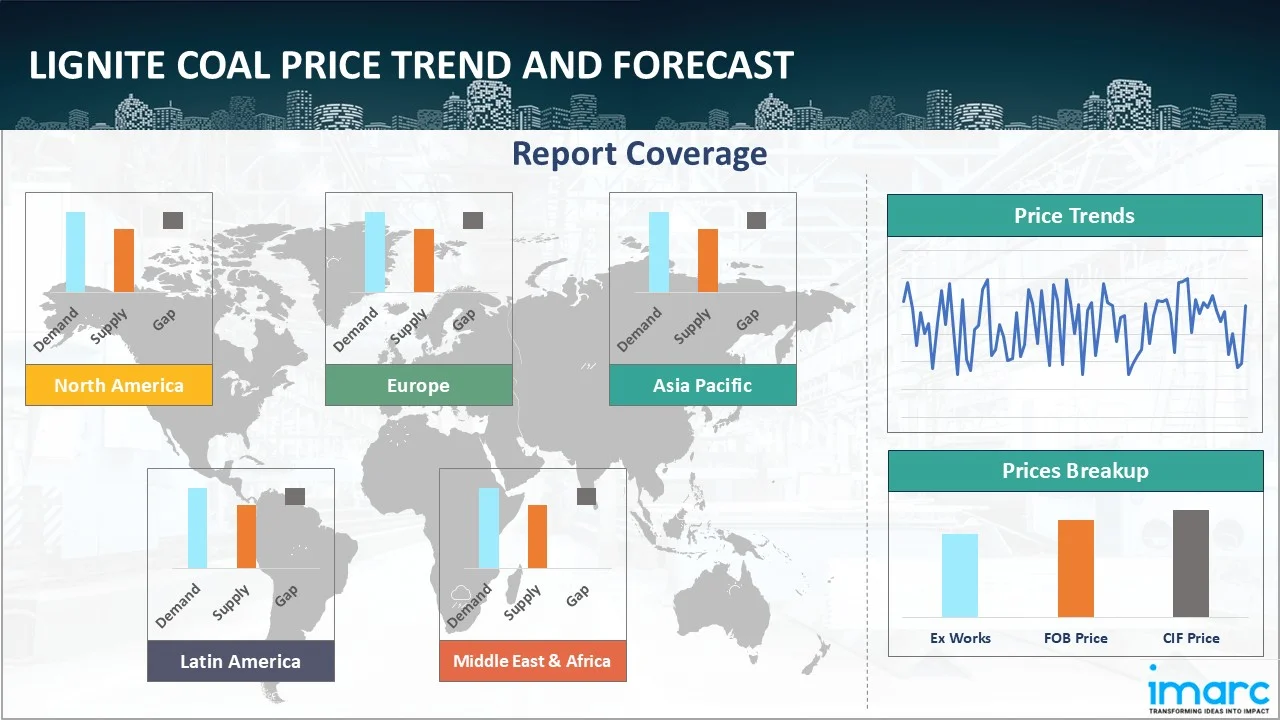
Lignite Coal Prices, Trend, Chart, Demand, Market Analysis, News, Historical and Forecast Data Report 2025 Edition
Lignite Coal Price Trend, Index and Forecast
Track real-time and historical lignite coal prices across global regions. Updated monthly with market insights, drivers, and forecasts.
Lignite Coal Prices December 2025
| Region | Price (USD/Kg) |
|---|---|
| Africa | 0.12 |
| Northeast Asia | 0.13 |
| Europe | 0.22 |
| Southeast Asia | 0.16 |
| North America | 0.16 |
Lignite Coal Price Index (USD/KG):
The chart below highlights monthly lignite coal prices across different regions.

Get Access to Monthly/Quarterly/Yearly Prices, Request Sample
Market Overview Q3 Ending September 2025
Africa: The pricing was influenced primarily by reduced industrial demand in South Africa and Mozambique, where slower energy sector activity affected consumption levels. On the supply side, domestic mining operations in these countries maintained steady output, but intermittent logistical bottlenecks, especially rail and port handling delays, added minor cost pressures. Currency fluctuations against the USD in countries such as Nigeria and Egypt slightly impacted import-dependent regions. Additionally, compliance costs related to environmental regulations and local mining royalties contributed to underlying cost structures. International shipping costs remained relatively stable, limiting sharp price fluctuations.
Northeast Asia: In Northeast Asia, lignite coal prices decreased slightly. Key factors included reduced thermal power demand in China and South Korea following seasonal adjustments in electricity consumption. Supply-side stability in Indonesia and Mongolia, major suppliers to the region, helped balance the market. Port handling and customs operations in China experienced minor delays, but international shipping costs were broadly unchanged, mitigating sharper price drops. Domestic logistics costs in Japan and Taiwan also remained steady. Additionally, fluctuations in regional currencies against the USD had a modest impact on import prices.
Europe: European lignite coal prices saw a significant decrease. This decline was primarily driven by lower energy consumption across Germany, Poland, and Greece, as renewable energy adoption reduced reliance on coal. Supply-side pressures were minimal, as domestic lignite mines continued regular output. However, logistical and compliance costs, including EU environmental regulations and carbon taxation, influenced market pricing. Currency fluctuations, especially the EUR/USD exchange rate, played a secondary role in import cost adjustments.
Southeast Asia: Major contributing factors included a slowdown in industrial activity in Thailand, Vietnam, and the Philippines, lowering regional demand. Supply from Indonesia remained stable, but port congestion and domestic transport costs in Vietnam and Thailand exerted some pressure on price stabilization. Currency fluctuations in countries like Indonesia and the Philippines also slightly affected import parity prices. Moreover, compliance costs associated with environmental and safety standards influenced production costs modestly. International shipping rates were steady, which limited further declines. Overall, weaker demand coupled with stable supply and logistical considerations drove the regional price reduction.
North America: North American lignite coal prices were relatively stable. The slight decline reflected steady demand in the United States and Canada, primarily from electricity generation and industrial usage. Domestic production remained robust, minimizing supply-side constraints. Transport logistics, including rail and port handling in key mining regions such as North Dakota and Texas, were consistent, contributing to price stability. Currency fluctuations had minimal impact, given the USD-denominated pricing. Additionally, regulatory compliance costs related to environmental standards were steady and did not cause significant price shifts. Overall, the market showed a minor downward adjustment while remaining largely stable throughout the quarter.
Lignite Coal Price Trend, Market Analysis, and News
IMARC's latest publication, “Lignite Coal Prices, Trend, Chart, Demand, Market Analysis, News, Historical and Forecast Data Report 2025 Edition,” presents a detailed examination of the lignite coal market, providing insights into both global and regional trends that are shaping prices. This report delves into the spot price of lignite coal at major ports and analyzes the composition of prices, including FOB and CIF terms. It also presents detailed lignite coal prices trend analysis by region, covering North America, Europe, Asia Pacific, Latin America, and Middle East and Africa. The factors affecting lignite coal pricing, such as the dynamics of supply and demand, geopolitical influences, and sector-specific developments, are thoroughly explored. This comprehensive report helps stakeholders stay informed with the latest market news, regulatory updates, and technological progress, facilitating informed strategic decision-making and forecasting.

Lignite Coal Industry Analysis
The global lignite coal industry size reached 720.2 Million Tons in 2025. By 2034, IMARC Group expects the market to reach 838.2 Million Tons, at a projected CAGR of 1.60% during 2026-2034. The market is driven by the demand for electricity generation in developing economies, availability of domestic lignite resources, cost-effectiveness compared to alternative fuels, and industrial consumption for cement and brick production.
Latest developments in the Lignite Coal Industry:
- August 2025: The Indian Power Ministry planned to develop an additional 97 GW of coal and lignite-based electricity generation capacity to achieve 307 GW of thermal capacity by 2034-35. Minister of State for Power Shripad Yesso Naik highlighted that India’s installed electricity capacity reached 485 GW in June 2025.
- June 2025: Gujarat Mineral Development Corporation announced plans to launch six new lignite mines across Gujarat between FY26 and FY28, according to a BSE filing. The mines, Lakhpat-Punrajpar, Ghala, Damlai, Valia, Panandhro Extension, and Bharkandam hold a total reserve of 400 million tons, with an estimated operational lifespan of up to 30 years, aiming to boost the state’s energy supply.
- February 2025: The Indian government launched a scheme, allocating ₹8,500 crore to promote coal/lignite gasification projects. The initiative targets the production of methanol, synthetic natural gas, and other chemicals, aiming to reduce import dependence and enhance energy security.
- September 2024: BNI Coal received federal approval to mine a new tract at its Center Mine in North Dakota. This marked one of only three such approvals in the U.S. over the past four years, underscoring the rigorous regulatory environment.
Product Description
Lignite coal is a brownish-black sedimentary material classified as low-rank coal. It ranks below bituminous coal in energy content but plays a significant role in regional energy production. Its high moisture content and relatively low carbon content define its characteristic combustion behavior. Lignite coal is primarily used in power generation, supplying electricity in thermal power plants. Additionally, it serves as a raw material in cement and brick manufacturing, contributing to consistent thermal performance and cost efficiency. Its abundant availability in regions like Europe, Southeast Asia, and North America makes it a reliable energy source, especially for domestic consumption.
Report Coverage
| Key Attributes | Details |
|---|---|
| Product Name | Lignite Coal |
| Report Features | Exploration of Historical Trends and Market Outlook, Industry Demand, Industry Supply, Gap Analysis, Challenges, Ammonia Price Analysis, and Segment-Wise Assessment. |
| Currency/Units | US$ (Data can also be provided in local currency) or Metric Tons |
| Region/Countries Covered | The current coverage includes analysis at the global and regional levels only. Based on your requirements, we can also customize the report and provide specific information for the following countries: Asia Pacific: China, India, Indonesia, Pakistan, Bangladesh, Japan, Philippines, Vietnam, Thailand, South Korea, Malaysia, Nepal, Taiwan, Sri Lanka, Hongkong, Singapore, Australia, and New Zealand* Europe: Germany, France, United Kingdom, Italy, Spain, Russia, Turkey, Netherlands, Poland, Sweden, Belgium, Austria, Ireland, Switzerland, Norway, Denmark, Romania, Finland, Czech Republic, Portugal and Greece* North America: United States and Canada Middle East & Africa: Saudi Arabia, UAE, Israel, Iran, South Africa, Nigeria, Oman, Kuwait, Qatar, Iraq, Egypt, Algeria, and Morocco* Latin America: Brazil, Mexico, Argentina, Columbia, Chile, Ecuador, Peru* *The list of countries presented is not exhaustive. Information on additional countries can be provided if required by the client. |
| Information Covered for Key Suppliers |
|
| Customization Scope | The report can be customized as per the requirements of the customer |
| Report Price and Purchase Option |
Plan A: Monthly Updates - Annual Subscription
Plan B: Quarterly Updates - Annual Subscription
Plan C: Biannually Updates - Annual Subscription
|
| Post-Sale Analyst Support | 360-degree analyst support after report delivery |
| Delivery Format | PDF and Excel through email (We can also provide the editable version of the report in PPT/Word format on special request) |
Key Benefits for Stakeholders:
- IMARC’s report presents a detailed analysis of lignite coal pricing, covering global and regional trends, spot prices at key ports, and a breakdown of FOB and CIF prices.
- The study examines factors affecting lignite coal price trend, including input costs, supply-demand shifts, and geopolitical impacts, offering insights for informed decision-making.
- The competitive landscape review equips stakeholders with crucial insights into the latest market news, regulatory changes, and technological advancements, ensuring a well-rounded, strategic overview for forecasting and planning.
- IMARC offers various subscription options, including monthly, quarterly, and biannual updates, allowing clients to stay informed with the latest market trends, ongoing developments, and comprehensive market insights. The lignite coal price charts ensure our clients remain at the forefront of the industry.
Key Questions Answered in This Report
The lignite coal prices in December 2025 were 0.12 USD/Kg in Africa, 0.13 USD/Kg in Northeast Asia, 0.22 USD/Kg in Europe, 0.16 USD/Kg in Southeast Asia, and 0.16 USD/Kg in North America.
The lignite coal pricing data is updated on a monthly basis.
We provide the pricing data primarily in the form of an Excel sheet and a PDF.
Yes, our report includes a forecast for lignite coal prices.
The regions covered include North America, Europe, Asia Pacific, Middle East, and Latin America. Countries can be customized based on the request (additional charges may be applicable).
Yes, we provide both FOB and CIF prices in our report.
Need more help?
- Speak to our experienced analysts for insights on the current market scenarios.
- Include additional segments and countries to customize the report as per your requirement.
- Gain an unparalleled competitive advantage in your domain by understanding how to utilize the report and positively impacting your operations and revenue.
- For further assistance, please connect with our analysts.
Why Choose Us
IMARC offers trustworthy, data-centric insights into commodity pricing and evolving market trends, enabling businesses to make well-informed decisions in areas such as procurement, strategic planning, and investments. With in-depth knowledge spanning more than 1000 commodities and a vast global presence in over 150 countries, we provide tailored, actionable intelligence designed to meet the specific needs of diverse industries and markets.
1000
+Commodities
150
+Countries Covered
3000
+Clients
20
+Industry
Robust Methodologies & Extensive Resources
IMARC delivers precise commodity pricing insights using proven methodologies and a wealth of data to support strategic decision-making.
Subscription-Based Databases
Our extensive databases provide detailed commodity pricing, import-export trade statistics, and shipment-level tracking for comprehensive market analysis.
Primary Research-Driven Insights
Through direct supplier surveys and expert interviews, we gather real-time market data to enhance pricing accuracy and trend forecasting.
Extensive Secondary Research
We analyze industry reports, trade publications, and market studies to offer tailored intelligence and actionable commodity market insights.
Trusted by 3000+ industry leaders worldwide to drive data-backed decisions. From global manufacturers to government agencies, our clients rely on us for accurate pricing, deep market intelligence, and forward-looking insights.
 Request Customization
Request Customization
 Inquire Before Buying
Inquire Before Buying
 Speak to an Analyst
Speak to an Analyst Request Brochure
Request Brochure




.webp)




.webp)












